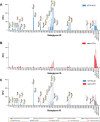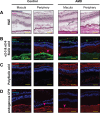The Sialome of the Retina, Alteration in Age-Related Macular Degeneration Pathology, and Potential Impacts on Complement Factor H
- PMID: 40576434
- PMCID: PMC12212450
- DOI: 10.1167/iovs.66.6.81
The Sialome of the Retina, Alteration in Age-Related Macular Degeneration Pathology, and Potential Impacts on Complement Factor H
Abstract
Purpose: Little is known about sialic acids of the human retina, despite their integral role in self /non-self-discrimination by complement factor H (FH), the alternative complement pathway inhibitor.
Methods: A custom sialoglycan microarray was used to characterize the sialic acid-binding specificity of native FH or recombinant molecules where IgG Fc was fused to FH domains 16 to 20 (which contains a sialic acid-binding site), domains 6 and 7 (which contains a glycosaminoglycan-binding site), or the FH-related proteins (FHRs) 1 and 3. We analyzed macular and peripheral retinal tissue from postmortem ocular globes for the amount, type, and presentation (glycosidic linkage type) of sialic acid in individuals with age-related macular degeneration (AMD) and age-matched controls using fluorescent lectins and antibodies to detect sialic acid and endogenous FH. Released sialic acids from neural retina, retinal pigmented epithelium (RPE) cells, and the Bruch's membrane (BrM) were labeled with 1,2-diamino-4,5-methylenedioxybenzene-2HCl (DMB), separated and quantified by high-performance liquid chromatography (HPLC).
Results: Both native FH and the recombinant FH domains 16 to 20 recognized Neu5Ac and Neu5Gc that is α2-3-linked to the underlying galactose. 4-O-Actylation of sialic acid and sulfation of GlcNAc did not inhibit binding. Different linkage types of sialic acid were localized at different layers of the retina. The greatest density of α2-3-sialic acid, which is the preferred ligand of FH, did not colocalize with endogenous FH. The level of sialic acids at the BrM/choroid interface of the macula and peripheral retina of individuals with AMD were significantly reduced.
Conclusions: The sialome of the human retina is altered in AMD. This may affect FH binding and, consequently, alternative complement pathway regulation.
Conflict of interest statement
Disclosure:
Figures



Update of
-
The sialome of the retina, alteration in age-related macular degeneration (AMD) pathology and potential impacts on Complement Factor H.bioRxiv [Preprint]. 2025 Mar 13:2025.03.09.642149. doi: 10.1101/2025.03.09.642149. bioRxiv. 2025. Update in: Invest Ophthalmol Vis Sci. 2025 Jun 2;66(6):81. doi: 10.1167/iovs.66.6.81. PMID: 40161805 Free PMC article. Updated. Preprint.
Similar articles
-
The sialome of the retina, alteration in age-related macular degeneration (AMD) pathology and potential impacts on Complement Factor H.bioRxiv [Preprint]. 2025 Mar 13:2025.03.09.642149. doi: 10.1101/2025.03.09.642149. bioRxiv. 2025. Update in: Invest Ophthalmol Vis Sci. 2025 Jun 2;66(6):81. doi: 10.1167/iovs.66.6.81. PMID: 40161805 Free PMC article. Updated. Preprint.
-
Bruch's membrane heparan sulfate retains lipoproteins in the early stages of age-related macular degeneration.Proc Natl Acad Sci U S A. 2025 Jun 17;122(24):e2500727122. doi: 10.1073/pnas.2500727122. Epub 2025 Jun 13. Proc Natl Acad Sci U S A. 2025. PMID: 40512794 Free PMC article.
-
Blue-light filtering intraocular lenses (IOLs) for protecting macular health.Cochrane Database Syst Rev. 2018 May 22;5(5):CD011977. doi: 10.1002/14651858.CD011977.pub2. Cochrane Database Syst Rev. 2018. PMID: 29786830 Free PMC article.
-
Differential analysis of core complement components expression and localization across rodent, non-human primate, and human ocular tissues.Exp Eye Res. 2025 Sep;258:110433. doi: 10.1016/j.exer.2025.110433. Epub 2025 May 24. Exp Eye Res. 2025. PMID: 40419209
-
Aflibercept for neovascular age-related macular degeneration.Cochrane Database Syst Rev. 2016 Feb 8;2(2):CD011346. doi: 10.1002/14651858.CD011346.pub2. Cochrane Database Syst Rev. 2016. PMID: 26857947 Free PMC article.
Cited by
-
Sialylation as a checkpoint for inflammatory and complement-related retinal diseases.Front Cell Neurosci. 2025 Jun 27;19:1623755. doi: 10.3389/fncel.2025.1623755. eCollection 2025. Front Cell Neurosci. 2025. PMID: 40656681 Free PMC article. Review.
References
MeSH terms
Substances
Grants and funding
LinkOut - more resources
Full Text Sources
Medical
Miscellaneous

